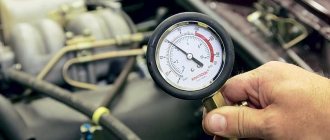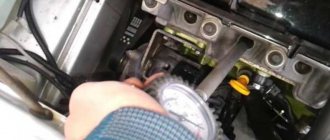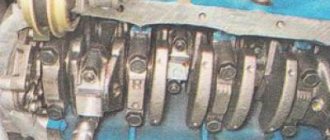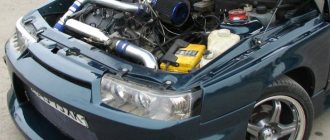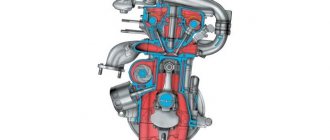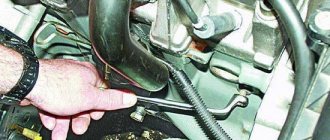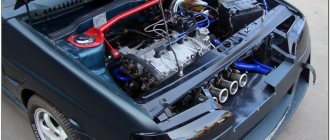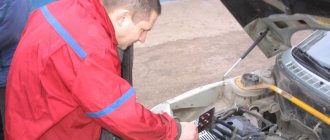01/26/2022 7,051 VAZ 2110
Author: Ivan Baranov
By measuring compression in cylinders, you can diagnose the parts of the power unit without disassembling it. For correct diagnosis, you need to know what compression should be in the VAZ 2110 engine. The article contains information on methods for measuring compression and detailed instructions with a video test of a 16-valve engine.
[Hide]
What compression in the cylinders of an 8-valve VAZ-2110 engine is considered normal?
Normal cylinder pressure on a VAZ-2110 with 8 valves should be from 10 to 12 atmospheres.
In some cases, the pressure in different cylinders may differ. If the indicator is 0.5-0.7 atmospheres, then such compression is normal and should not cause concern.
Reasons for falling below compression:
- The cylinder block gasket has burnt out;
- Burnt out pistons or valves;
- The cylinder-piston unit is worn out;
- Valve seats are damaged or destroyed;
- A crack has formed in the exhaust valve disc.
AvtoVAZ indicates the normal compression level and compression ratio for each engine. Many users confuse the characteristics, considering them one of the same. The compression ratio is the ratio of the total volume of the cylinder to the volume of the combustion chamber. To calculate the optimal compression ratio for an engine, use the formula:
Compression = Compression Ratio * K Factor.
In the case of gasoline engines, the coefficient is 1.2, while for diesel versions it is 1.8.
Engine Lada Vesta
Products from the assortment of Dustershop77 on the topic of the article: Image
| vendor code | Name | Manufacturer | Price | Availability | Add to cart |
| DC1300-20182 | Throttle valve gasket kit K4M/F4R (large+small) ROSTECO | Analogue | 500 / 350 rub. Discount: 250 rub. | 2 | |
| DC380-ASAM-30376 | Radiator mounting pad ASAM-SA 30376 analog art. 7700430992 / 215081131R | Analogue | 150 / 100 rub. Discount: 80 rub. | 5 | |
| DC800-8200291355 | Crankcase gas recirculation valve Renault 8200291355 | Original | 4500 / 3900 rub. Discount: 3200 rub. | 3 | |
| DC919-226A41772R | Oxygen sensor lambda probe upper Duster, Vesta and other engines. H4M 1.6 226A41772R / 226901841R / 226906393R | Original | 4500 / 4200 rub. Discount: 3900 rub. | 5 | |
| DC1211-8200132254 | Fuel injector for K4M engine original 8200132254 | Original | 2200 / 1900 rub. Discount: 1600 rub. | 8 | |
| DC1321-161757436R | Throttle valve gasket H4M original 161757436R | Original | 800 / 600 rub. Discount: 500 rub. | 1 | |
| DC619-8200048024 | Expansion tank cover original Renault 8200048024 | Original | 700 / 500 rub. Discount: 250 rub. | 1 | |
| DC981-FCR210114 | Electric fuel pump FRANCECAR FCR210114 | Analogue | 1500 / 1200 rub. Discount: 1100 rub. | 2 | |
| DC1398-30777 | Gasket for fuel pump ring ASAM 30777 | ASAM | 300 / 200 rub. Discount: 150 rub. | 3 | |
| DC1200-BK64105/30598 | Fuel pump ring with gasket | Analogue | 1000 / 700 rub. Discount: 500 rub. | 3 | |
| DC1322-224332428R | Ignition coil 1.6 H4m original 224332428R | Original | 2900 / 2500 rub. Discount: 2100 rub. | 2 | |
| LRT-002/6001548140 | Washer reservoir is not original, ANALOGUE 6001548140 | LOGEM | 1000 / 900 rub. Discount: 500 rub. | 1 | |
| DC382-ASAM-30494 | Expansion tank ASAM-SA 30494 (7701470460) | Analogue | 1000 / 700 rub. Discount: 600 rub. | 1 | |
| DC1314-135101KT0A | Front crankshaft oil seal H4M original 135101KT0A | Original | 900 / 700 rub. Discount: 550 rub. | 2 | |
| DC1320-161191KA1B | Throttle valve H4M original 161191KA1B | Original | 25000 / 18900 rub. Discount: 17900 rub. | 1 | |
| DC1746 | Membrane of the crankcase gas recirculation valve Renault Duster, Captur, Terrano, etc. (KVKG membrane F4R 2.0) | Analogue | 2200 / 1700 rub. Discount: 1500 rub. | 2 | |
| DC1766 | Throttle valve gasket repair kit K4M/F4R (large+small) Balakovo PTP64 | Analogue | 300 / 200 rub. Discount: 150 rub. | 2 | |
| 6001548140 | Washer reservoir Renault 6001548140 original | Original | 2000 / 1700 rub. Discount: 1500 rub. | 1 | |
| DC918-226A44171R | Oxygen sensor lower lambda probe H4M 1.6 Lambda probe Renault 226A44171R | Original | 11000 / 10500 rub. Discount: 9900 rub. | 1 | |
| DC955-150100565R | Oil pump for F4R original 150100565R | Original | 5500 / 4800 rub. Discount: 4400 rub. | 1 | |
| DC957-8200665520 | Starter K4M 1.6 original 8200665520 | Original | 12000 / 9900 rub. Discount: 9500 rub. | 1 | |
| DC1302-166008992R | Fuel injector for H4M engine original 166008992R | Original | 3500 / 2600 rub. Discount: 2400 rub. | 4 | |
| DC1315-122791HC0A | Rear crankshaft oil seal H4M original 122791HC0A | Original | 2000 / 1700 rub. Discount: 1400 rub. | 1 | |
| DC1663-21120370501015 | Ignition coil VAZ 1.6/1.8 21129/21179 original 21120370501015 | Original | 1900 / 1200 rub. Discount: 900 rub. | 4 | |
| DC1664-21179113201000 | Fuel injector VAZ 1.8l 2179 original 21179113201000 | Original | 1800 / 1500 rub. Discount: 1300 rub. | 4 | |
| DC1643-140323253R | Intake manifold gasket H4M original 140323253R | Original | 1900 / 1500 rub. Discount: 1400 rub. | 1 | |
| DC1644-140328698R | Intake manifold gasket H4M original 140328698R | Original | 700 / 600 rub. Discount: 400 rub. | 4 | |
| DC1738 | Fuel pump fuel filter mesh Renault Duster, Captur, Terrano, Vesta, etc. 2.0 / 1.6 (Masuma) | Analogue | 800 / 500 rub. Discount: 350 rub. | 1 | |
| DC522-233009370R | Starter for F4R engine original art. 233009370R | Original | 14000 / 10600 rub. Discount: 9900 rub. | ||
| DC1682-6001549070 | Fuel vapor absorber original 6001549070 | Original | 3300 / 2500 rub. Discount: 2000 rub. | ||
| DC1740 | Fuel filter for submersible fuel pump Renault Duster, Captur, Terrano, Vesta, etc. 2.0 / 1.6 (LYNX) | Analogue | 2100 / 1800 rub. Discount: 1400 rub. | ||
| DC1002-B208A03276 | Fuel injector for K4M DEKO engine B208A03276 (analogue 8200132254) | Analogue | 2000 / 1500 rub. Discount: 1300 rub. |
Pressure measurement
We have already answered what the normal compression for a VAZ 2114 should be. Now let's look at how to actually measure it? First we need a special device called a compression meter.
All measurements using it are performed in the following order:
To measure pressure you will need a device - a compression meter. Using a compression gauge, take measurements in the following order:
- Fully charge the battery;
- Warm up the engine to 75-90 C°;
- After the engine warms up, remove all spark plugs;
- Disconnect the fuel supply hose;
- Insert the measuring device into the first spark plug hole;
- Press the gas pedal and hold it (you will need an assistant);
- Start the starter and turn the crankshaft with it;
- Wait until the readings on the dial (monitor) of the device reach the maximum - the indicator will be the compression value in a particular cylinder;
- Move the compression gauge to another spark plug hole and repeat the measurements.
After the pressure is measured in all cylinders, conclusions can be drawn about the general condition of the engine and the need for its repair/restoration.
After checking all cylinders, it is possible to draw a conclusion about the condition of the engines, as well as determine the need for restoration, repair or replacement.
If the compression norm is violated, it is recommended to stop traveling by car and get it repaired. Operating the vehicle in this condition may result in engine damage.
Source
Some conclusions
The steel receiver looks powerful and beautiful
All VAZ-2112 hatchback engines differ in characteristics, and the differences are significant. It seems that the best option would be a 16-valve 1.5-liter engine. But the 21124 (1.6) engine has its advantages:
Any 21124 engine can be converted to Euro-4 or meets these standards immediately.
The appearance of the 1.5 liter engine inspires respect. But if you remember about bending the valves, the choice becomes difficult to make. A steel receiver and a beautiful schedule are not everything.
Various nuances
Motor 21124 is more modern than its brother. It has spark plugs with individual coils installed on it. Experienced craftsmen also know about the tuning possibilities specific to the 21120 engine (for example, installing a turbine). In defense of the latter, we can say the following: the service life of the two engines under consideration is approximately the same. After the first 120 thousand, the 20th engine deserves a rating of “4.5 out of 5”.
On the secondary market, VAZ-21120 and 21126 (Priora) engines are valued almost equally. But the VAZ-21124 unit is in short supply. Draw conclusions.
Normal compression on a VAZ-2110
Typically, compression is checked using a special device. It is recommended to do this regularly.
This helps determine the degree of wear of the motor and rings, as well as the piston itself. Normal cylinder pressure on a VAZ-2110 with 8 valves should be from 10 to 12 atmospheres .
Normal compression in the cylinder.
It is also worth noting that sometimes the pressure in different cylinders may differ . If it is 0.5-0.7 atmospheres , then this phenomenon is normal and should not cause concern.
Abnormal compression
This happens when there are more or less atmospheres in the cylinder than in others.
Such an engine will not be able to operate normally. He absolutely needs to carry out repairs.
Causes
Burnout of the gasket between the block and the head is a fairly common defect.
Debugg
Eliminating the causes of a drop in compression in one of the cylinders directly depends on what was to blame for its occurrence.
Most often, this problem occurs due to the occurrence of rings. The formation of carbon deposits (coking) in one of the cylinders occurs due to the penetration of a large amount of oil into it.
For example, this can happen if the valve stem seals for that cylinder are damaged.
The difficulty of repairing compression loss caused by rings depends on the nature of the damage.
If they just lay there, then you can try to decarbonize them. But if the rings burst, then you will have to disassemble almost the entire engine to replace the damaged elements.
The same applies to valves. If they are misadjusted, it is enough to bring the thermal gaps back to normal. But if the valves and their seats are burnt, then repair work is carried out on the cylinder head - the valves are changed and they are ground in.
Regarding the cylinder head gasket, if it’s all because of it, then they change it. But with the block head, not everything is so simple.
If it was caused by overheating, then you can still fix the problem by trimming the surface.
But if defects form in the body of the head, it is replaced. Any piston malfunction is definitely a replacement.
How to install a compressor with your own hands?
When the old device is faulty, you need to install a new one (see photo). The installation of a compressor on a VAZ is carried out in a short period. This is not a labor-intensive process, but requires extreme care and caution. To work you will have to equip yourself with the following equipment:
- set for compressor installation;
- keys;
Compressor installation diagram
- air filter system;
- pressure controller;
- paste based on abrasive components.
Before starting work, make sure that the power unit has completely cooled down, otherwise you may get burned. The work begins with dismantling the air duct and filter. The manifold clamps are removed. Now the fasteners of the part, which is popularly called a snail, are installed on the motor block.
We replace the drive belt with a belt taken from the compressor unit kit. It is more efficient, reliable and will last much longer. We adjust the belt so that it is not too tight, but not too loose. The next stage is the installation of the air duct and fastening of the pressure controller.
A filter is attached to the compressor outlet. The last stage of the work is to adjust the injector so that the power unit does not receive a lean mixture. It’s better to check this at a service center, since doing this operation yourself is problematic.
This is the entire list of work to replace the compressor. It may seem too complicated for a beginner, but in fact there is nothing difficult here. You should carry out the described work 1-2 times in the presence of a knowledgeable master, and this skill will be practiced to an automatic level.
Over time, car parts wear out, not only the chassis, but also the engine. Why is a cylinder compression test required? For example, you are buying a used car, and in order to find out what condition the engine is in, it is better to play it safe and check the compression so that you do not have to do a major overhaul after a couple of months. I bought my 10 when it was 5 years old; by that time the mileage was no longer low (about 90,000). When inspecting the car, I had a specialist with me who checked the compression in the cylinders.
If you notice that the engine does not pull, and at the same time the fuel and oil consumption has increased, then you should perform engine diagnostics. You can determine the causes of engine ailments without disassembling if you measure the compression in the engine cylinders. Engine compression is the pressure in the cylinders at the end of the compression stroke. It is measured in kg/cm2, bar, MPa or atmospheres. When the VAZ compression is high, then fewer gases will break into the engine crankcase and, therefore, more gases will do useful work, and this will have a positive impact on engine power. Thus, compression in the engine affects throttle response, engine stability, gasoline and oil consumption. Low engine compression will lead to a drop in engine power, a decrease in the vehicle's maximum speed, worse acceleration dynamics, and an increase in the amount of fuel and oil consumed.
Why do you need to check?
It is recommended to measure compression at least once every 15-20 thousand kilometers. Its deviation to a lesser extent leads to the fact that the fuel mixture is not compressed to the required level and ignites at a slower rate, as a result of which the engine overheats and its power is significantly reduced.
Increased compression, on the contrary, causes early ignition of the mixture, as a result of which it detonates, creating additional loads on the piston elements.
If there is a difference in compression in the cylinders of one engine, the mixture will ignite at different rates, creating an imbalance in the coordinated operation of the pistons and camshaft(s).
What does low compression lead to?
Most often, compression in the cylinders does not increase, but decreases. This may be a consequence:
- wear or damage to compression rings;
- wear or burnout of valves;
- damage to the cylinder head gasket;
- cracks in the cylinder head.
These problems can cause:
- reducing engine power;
- deterioration of dynamic performance;
- increased fuel consumption;
- “forcing” oil into the air filter housing (in carburetor engines);
- oil getting inside the combustion chambers (the engine “eats” oil, which is characterized by bluish exhaust smoke).
If you find the listed signs in your car, be prepared to at least replace the piston and, at maximum, overhaul the engine. But before you start repairing it, you should make sure that the compression is really low.
Repair
As can be seen from the above, there are many reasons for different compression in the cylinders. In this case, it is not always possible to carry out repairs yourself, especially if you do not have the skills. In this case, it is recommended to contact specialists at a service station.
Traditional methods of increasing compression
It is noted that the methods described below cannot be a 100% guarantee that compression in the cylinders will increase.
- Buy a quality valve cleaning fluid and pour it into the oil.
- Pour this liquid into the cylinders overnight.
Examination
It is recommended to check the compression on the VAZ 2110 regularly to prevent possible malfunctions and problems with the engine. Measurements are taken with the throttle valve open and closed. Each test option gives its own results and data on the condition of the engine.
Checking with the valve open allows you to determine:
- Problems and damage on cylinder surfaces;
- Deformation, burnout of valves;
- Sticking or coking of piston rings.
If you check the compression with the throttle closed, you can find out:
- Are the valves stuck?
- Is there a tight fit to the valve seat?
- If a hydraulic tappet is present, the presence of defects in the camshaft cam profile is determined.
Now you can proceed directly to the verification.
- Warm up the engine until it reaches operating temperature, then turn off the ignition.
- Turn off the fuel pump. If it is a mechanical pump, the tubes are disconnected and the fuel supply is cut off. In the case of an electric fuel pump, simply turn off the fuel supply relay and remove the fuse.
- Relieve the pressure that is inside the fuel system.
- Start the engine. This way the engine will be able to use up all the fuel that remains in the system. Wait until the engine comes to a complete stop.
- Now we continue to measure the compression.
- Disconnect the ignition module.
- Disconnect the spark plugs from the high-voltage circuits, then use a special spark plug wrench to unscrew them from their sockets.
- Insert a measuring device into the spark plug socket. On each cylinder, that is, when connecting the device to each hole, measurements are taken separately.
- Invite an assistant. His job is to sit in the driver's seat and press the gas pedal to open the throttle.
- At the same time, the engine starts for 5-10 seconds.
- At this moment you are taking readings from the measuring device.
- Using a similar method, you should take measurements on each cylinder, resetting the readings of the previous one on the device. Record your findings.
Design features
The main part of the engine, the cylinder block (catalog number 11193-1002011), also differs in size from its predecessor. It is factory painted blue. Its height, the distance from the crankshaft axis to the upper plane, became 197.1 mm, versus 194.8 mm on the 2112 model.
The dimensions of the holes for the block head mounting bolts have changed; they are from the hoist with M10×1.25 threads. The main bearing supports on the 124th engine, from the second to the fifth, are equipped with channels designed to supply oil that cools the piston during operation.
The crankshaft installed is the same as on models 21126 and 11194, with the marking 11183 cast on the sixth counterweight. Due to the crank radius of 37.8 mm, a piston stroke of 75.6 mm was provided. A toothed pulley is installed on the shaft for timing belt drive. The belt is 25.4 mm wide and has 136 teeth, parabolic in shape. Belt service life is 45,000 km.
The pulley is designed to drive additional units using a V-belt. Three types of belts are used, differing in length, depending on the equipment:
The pulley is designed in such a way that it acts as a damper, reducing the torque loads acting on the shaft. Another function is to determine the position of the crankshaft using a sensor and a gear mounted in the damper.
The improvement affected the pistons. Their bottoms are made with valve recesses 5.53 mm deep to avoid the valves hitting the piston bottom when the timing belt breaks.
On previous VAZ 16v models without recesses or with recesses of shallower depth, in such a situation there was a risk of bending the valves, which led to expensive repairs. So, concerns and frequently arising questions about whether the valves bend on this engine have been removed.
Oil scraper and compression rings are made of steel or cast iron. The pistons and connecting rods are connected using floating pins, 22 mm in diameter, 60.5 mm in length, secured with retaining rings. The pins and connecting rods are borrowed from the VAZ 2110 modification.
The block head for the 16 valve LADA 21124 engine has an enlarged docking area for the intake manifold flange. Both camshafts for the exhaust and intake valves, as well as the valves themselves, springs, and hydraulic compensators have also been preserved from the previous modification of the engine.
In order to avoid confusion, the shafts are marked with a digital code. If it ends at 14, then this is the exhaust valve shaft, if at 15, then this is the intake shaft.
Another difference is that there is a raw strip on the intake shaft, next to the first pushrod. By adding hydraulic compensators to the design, the manufacturer eliminated the need to maintain valves in terms of adjustment. But, they are very sensitive to the cleanliness and quality of the lubricant. Low-quality oil will quickly damage parts and must be replaced; such repairs are not provided for the VAZ 124.
The spring-valve group is similar to model 2112. Valves with one spring and rods with a diameter of 7 mm (on eight-valve heads their diameter is 8 mm). Toothed pulleys with marks for setting the valve timing are installed on the camshafts. Compared to model 2112, the marks are shifted relative to each other by 2°.
Just like the shafts, the pulleys have differences in design and markings - on the inlet, a strip is welded on the back side, on the outlet it is missing. Both pulleys have markings in the form of circles on the hub.
Correct belt tension is done using support and tension rollers with flanges (to eliminate the possibility of slipping).
The cylinder head gasket is made from asbestos-free material. The holes for the cylinders are made with metal edging.
The intake manifold is combined with the receiver and is made of plastic.
For the first time in cars of the VAZ 2110 family, a catalytic converter was installed, combined with an exhaust manifold. Depending on what EURO 4 or 5 requirements the 124 motor is designed for, a different type of collector is installed.
The design of the fuel rail was updated and it began to be made from stainless steel. The drain line was removed from the fuel system; instead, a bypass valve was installed on the pump to relieve excess pressure. To supply fuel directly to the cylinders, nozzles manufactured by Bosch and Siemens were used.
The ignition coils were installed on spark plugs, each spark plug had its own individual coil, with additional fixation to the valve cover. With this method, high-voltage wires were no longer needed, and the ignition control began to be carried out by Bosch M7.9.7 or Russian January 7.2 control units, intended for EURO-4 and 3.
